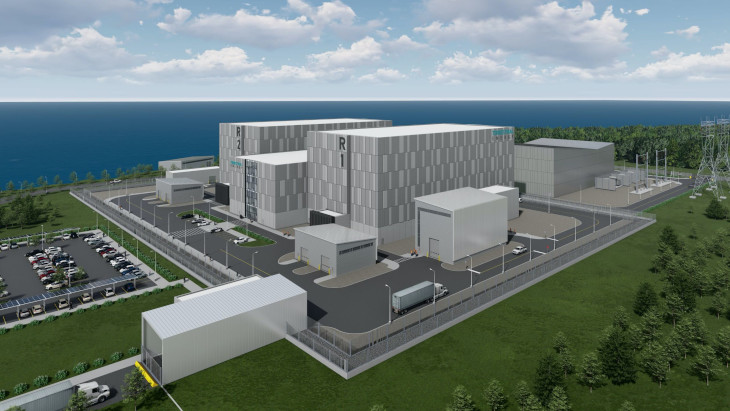The Canadian Nuclear Safety Commission (CNSC) has completed Phase 2 of the vendor design review (VDR) of Terrestrial Energy's Integral Molten Salt Reactor (IMSR). The regulator said that no fundamental barriers to licensing the small modular reactor design were identified during the review.

An IMSR400 plant (Image: Terrestrial Energy)
The VDR is an optional service provided by the CNSC to provide an assessment of a nuclear power plant design based on a vendor's reactor technology. It is not a required part of the licensing process for a new nuclear power plant but aims to verify the acceptability of a design with respect to Canadian nuclear regulatory requirements and expectations, providing early feedback during the design process.
In February 2016, a service agreement was signed between the CNSC and Terrestrial for the conduct of a Phase 1 VDR of the IMSR. During this phase, CNSC staff assessed how the vendor's design processes demonstrate intent to meet CNSC requirements. The Phase 1 review of the ISMR was completed in November 2017.
The CNSC entered into an agreement with Terrestrial in May 2018 to conduct the second phase of the VDR of the reactor design. Phase 2 of the review focuses on identifying whether there are any potential fundamental barriers to licensing.
The VDR involved a comprehensive review of the IMSR design covering 19 'focus areas' defined by the CNSC and required Terrestrial's preparation of hundreds of technical submissions. Its scope included a systematic review of Terrestrial's engineering management processes, confirmatory testing programme for IMSR components and systems, reactor controls and safety systems, defence-in-depth strategy, safety analysis, and the requirements for safeguards, security, fire protection and radiation protection.
CNSC staff have now concluded that there are no fundamental barriers to licensing the IMSR plant.
"The IMSR design requires further advancement in some areas for CNSC staff to confirm that it meets all Canadian regulatory expectations. Terrestrial will be required to perform additional work to address the technical clarifications and findings raised in this review, should it or another proponent pursue a licence for the design," the CNSC noted.
"The VDR is a comprehensive pre-licensing regulatory review, and its completion is a breakthrough for Terrestrial Energy," said Terrestrial CEO Simon Irish. "Its scope and conclusion provide commercial confidence to proceed to licensing and construction of IMSR plants.
"It is the first technology review completed by a major regulator of a nuclear plant design that uses a Generation IV reactor technology to supply heat at high temperature, and the first time for molten salt reactor technology," he noted.
"This review is a major step to bring molten salt technology to commercial markets and IMSR plants to large industrial companies seeking practicable high-impact solutions to decarbonise industrial production."
Terrestrial's IMSR is a 4th generation reactor that uses molten salt as both fuel and coolant, with integrated components, which can supply heat directly to industrial facilities or use it to generate electrical power. The use of molten salt as both fuel and coolant also enables passive, or inherent, safety features to be built into the reactor design. The design integrates the primary reactor components, including the graphite moderator, into a sealed and replaceable reactor core unit with an operating lifetime of seven years. Terrestrial's IMSR400 configuration, with twin reactors and generators, will mean an overall power plant design with a potential output of up to 390 MWe.